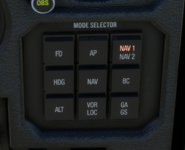La touche APP est baptisée VOR LOC sur ton PA
L'indicateur GA GS doit s'allumer si ton PA détecte un ILS
En résumé, pas sur que ton PA gère l'approche.
-----------------------------------------------------------------------------------------------------------------------------------------------------------------------
Doc trouvée sur le net ( utile ?)
FD - This engages the Flight Director, which simply shows the pilot where the autopilot wants you to fly. In this mode the autopilot servos are not necessarily engaged.
AP - This is what actually engages the autopilot. If you press just this button and no others, the autopilot defaults to Pitch Hold and Roll Hold modes. It will simply attempt to maintain the current pitch and bank. In this mode (i.e. with no other modes engaged) you can use the lower pedestal panel to control pitch and roll (the pitch wheel will command the autopilot to hold a nose-up or nose-down attitude, and the roll wheel commands it to hold a bank angle).
NAV 1/ NAV 2 - This is an annunciator to tell you whether the autopilot has nav information; It seems to always be on.
HDG - This button engages heading mode, where the autopilot will turn to follow the orange heading bug on the HSI.
NAV - In this mode the autopilot will attempt to intercept and track along whatever Nav course is set on the HSI (with the yellow needle). If you're heading away from the course you'll have to turn the plane with HDG mode or manually to intercept before the autopilot will capture the course. It won't turn for you.
BC - This is the Back Course mode, used in conjunction with APP (approach) mode. This is used when the plane needs to track inbound on a localizer back course (some instrument approaches require that; this is a separate mode because while flying inbound on a localizer back course the guidance is backward! So the autopilot needs to know that so it will make corrections in the right direction).
ALT - This engages the altitude hold mode. There is no altitude selector anywhere, so it will simply attempt to hold whatever altitude you are at when the mode is engaged. So be sure to have the plane flying mostly level and mostly trimmed up when you hit this button, otherwise you'll get a wild ride as the autopilot attempts to correct!
 APP - This is the approach mode. When you engage it NAV mode is also engaged. It works the same as NAV mode, but will additionally sense and follow a glideslope, as on an ILS approach.
APP - This is the approach mode. When you engage it NAV mode is also engaged. It works the same as NAV mode, but will additionally sense and follow a glideslope, as on an ILS approach.
GA / GS - This is another annunciator, and simply tells you whether the autopilot is detecting a glideslope or not.
If you want to use the autopilot to climb or descend I'd recommend doing this: With the autopilot off, select HDG mode. This will put the autopilot in HDG mode to follow your heading bug, but since no pitch mode has been selected the autopilot is simply in its default pitch hold mode. Now you can use the pitch wheel on the lower panel to command some nose-up or nose-down. You can fine-tune this to get the climb/descent rate you want.


